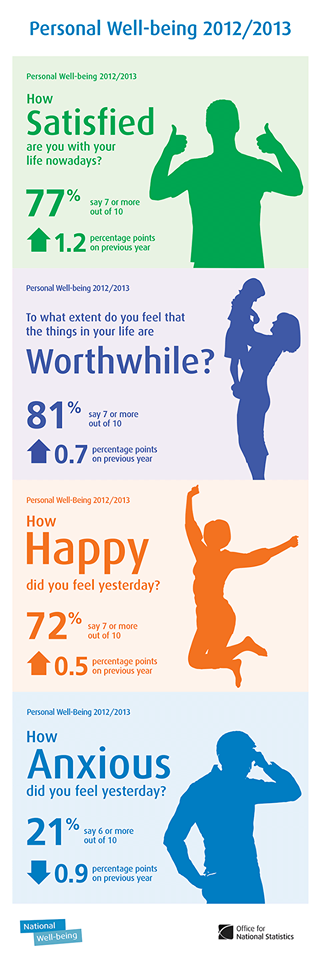|
Broaden-and-build
The broaden-and-build theory in positive psychology suggests that positive emotions (such as happiness, and perhaps interest and anticipation) broaden one's awareness and encourage novel, exploratory thoughts and actions. Over time, this broadened behavioral repertoire builds useful skills and psychological resources. The theory was developed by Barbara Fredrickson around 1998. Positive emotions have no immediate survival value, because they take one's mind off immediate needs and stressors. However, the skills that broadened behavior strengthens over time enhance survival. For example, curiosity about a landscape becomes navigational knowledge, pleasant interactions with a stranger become a supportive friendship, and aimless physical play becomes valuable exercise. According to Fredrickson, the resources gained through positive emotions outlive the emotions from which they were acquired. Resources build up over time and increase the individual's overall well-being. This forms a p ... [...More Info...] [...Related Items...] OR: [Wikipedia] [Google] [Baidu] |
Barbara Fredrickson
Barbara Lee Fredrickson (born June 15, 1964) is an American professor in the department of psychology at the University of North Carolina at Chapel Hill, where she is the Kenan Distinguished Professor of Psychology. She is also the Principal Investigator of the Positive Emotions and Psychophysiology Lab (PEPLab) at the University of North Carolina at Chapel Hill. Fredrickson is a social psychologist who conducts research in emotions and positive psychology. Her main work is related to her broaden-and-build theory of positive emotions, which suggests that positive emotions lead to novel, expansive, or exploratory behavior, and that, over time, these actions lead to meaningful, long-term resources such as knowledge and social relationships. She is the author of ''Positivity: Top-Notch Research Reveals the 3-to-1 Ratio That Will Change Your Life'' (2009), a general-audience book that draws on her own research and that of other social scientists. The book's thesis is largely drawn f ... [...More Info...] [...Related Items...] OR: [Wikipedia] [Google] [Baidu] |
Creativity
Creativity is a phenomenon whereby something new and valuable is formed. The created item may be intangible (such as an idea, a scientific theory, a musical composition, or a joke) or a physical object (such as an invention, a printed literary work, or a painting). Scholarly interest in creativity is found in a number of disciplines, primarily psychology, business studies, and cognitive science. However, it can also be found in education, the humanities (philosophy, the arts) and theology, social sciences (sociology, linguistics, economics), engineering, technology and mathematics. These disciplines cover the relations between creativity and general intelligence, personality type, mental and neural processes, mental health, artificial intelligence; the potential for fostering creativity through education, training, leadership and organizational practices; the factors that determine how creativity is evaluated and perceived; the fostering of creativity for national economic bene ... [...More Info...] [...Related Items...] OR: [Wikipedia] [Google] [Baidu] |
Positive Affectivity
Positive affectivity (PA) is a human characteristic that describes how much people experience positive affects (sensations, emotions, sentiments); and as a consequence how they interact with others and with their surroundings. People with high positive affectivity are typically enthusiastic, energetic, confident, active, and alert. Research has linked positive affectivity with an increase in longevity, better sleep, and a decrease in stress hormones. People with a high positive affectivity have healthier coping styles, more positive self-qualities, and are more goal oriented. Positive affectivity also promotes an open-minded attitude, sociability, and helpfulness. Those having low levels of positive affectivity (and high levels of ''negative'' affectivity) are characterized by sadness, lethargy, distress, and un-pleasurable engagement (see negative affectivity). Low levels of positive affect are correlated with social anxiety and depression, due to decreased levels of dopamine. ... [...More Info...] [...Related Items...] OR: [Wikipedia] [Google] [Baidu] |
Positive Psychology
Positive psychology is the scientific study of what makes life most worth living, focusing on both individual and societal well-being. It studies "positive subjective experience, positive individual traits, and positive institutions...it aims to improve quality of life." It is a field of study that has been growing steadily throughout the years as individuals and researchers look for common ground on better well-being. Positive psychology began as a new domain of psychology in 1998 when Martin Seligman chose it as the theme for his term as president of the American Psychological Association. It is a reaction against past practices, which have tended to focus on mental illness and emphasized maladaptive behavior and negative thinking. It builds on the humanistic movement by Abraham Maslow, Rollo May, James Bugental, and Carl Rogers, which encourages an emphasis on happiness, well-being, and positivity, thus creating the foundation for what is now known as positive psychology. P ... [...More Info...] [...Related Items...] OR: [Wikipedia] [Google] [Baidu] |
Subjective Well-being
Subjective well-being (SWB) is a self-reported measure of well-being, typically obtained by questionnaire. Ed Diener developed a tripartite model of subjective well-being in 1984, which describes how people experience the quality of their lives and includes both emotional reactions and cognitive judgments. It posits "three distinct but often related components of wellbeing: frequent positive affect, infrequent negative affect, and cognitive evaluations such as life satisfaction." Subjective well-being is an overarching ideology that encompasses such things as "high levels of pleasant emotions and moods, low levels of negative emotions and moods, and high life-satisfaction." SWB therefore encompasses moods and emotions as well as evaluations of one's satisfaction with general and specific areas of one's life. SWB is one definition of happiness. Although SWB tends to be stable over the time and is strongly related to personality traits, the emotional component of SWB can be i ... [...More Info...] [...Related Items...] OR: [Wikipedia] [Google] [Baidu] |
Meaning Of Life
The meaning of life, or the answer to the question: "What is the meaning of life?", pertains to the significance of living or existence in general. Many other related questions include: "Why are we here?", "What is life all about?", or "What is the purpose of existence?" There have been many proposed answers to these questions from many different cultural and ideological backgrounds. The search for life's meaning has produced much philosophical, scientific, theological, and metaphysical speculation throughout history. Different people and cultures believe different things for the answer to this question. The meaning of life can be derived from philosophical and religious contemplation of, and scientific inquiries about existence, social ties, consciousness, and happiness. Many other issues are also involved, such as symbolic meaning, ontology, value, purpose, ethics, good and evil, free will, the Existence of God, existence of one or multiple gods, conceptions of God, the So ... [...More Info...] [...Related Items...] OR: [Wikipedia] [Google] [Baidu] |
Religious Practice
Religion is usually defined as a social-cultural system of designated behaviors and practices, morals, beliefs, worldviews, texts, sanctified places, prophecies, ethics, or organizations, that generally relates humanity to supernatural, transcendental, and spiritual elements; however, there is no scholarly consensus over what precisely constitutes a religion. Different religions may or may not contain various elements ranging from the divine, sacred things, faith,Tillich, P. (1957) ''Dynamics of faith''. Harper Perennial; (p. 1). a supernatural being or supernatural beings or "some sort of ultimacy and transcendence that will provide norms and power for the rest of life". Religious practices may include rituals, sermons, commemoration or veneration (of deities or saints), sacrifices, festivals, feasts, trances, initiations, funerary services, matrimonial services, meditation, prayer, music, art, dance, public service, or other aspects of human culture. Religions have sa ... [...More Info...] [...Related Items...] OR: [Wikipedia] [Google] [Baidu] |
Life Satisfaction
Life satisfaction is a measure of a person's well-being, assessed in terms of mood, relationship satisfaction, achieved goals, self-concepts, and self-perceived ability to cope with life. Life satisfaction involves a favorable attitude towards one's life—rather than an assessment of current feelings. Life satisfaction has been measured in relation to economic standing, degree of education, experiences, residence, and other factors. Life satisfaction is a key part of subjective well-being. Many factors influence subjective well-being and life satisfaction. Socio-demographic factors include gender, age, marital status, income, and education. Psychosocial factors include health and illness, functional ability, activity level, and social relationships. People tend to gain life satisfaction as they get older. Factors affecting life satisfaction Personality A meta-analysis using The Big Five personality model found that, among the Big Five, low neuroticism was the strongest pred ... [...More Info...] [...Related Items...] OR: [Wikipedia] [Google] [Baidu] |
Hedonic Treadmill
The hedonic treadmill, also known as hedonic adaptation, is the observed tendency of humans to quickly return to a relatively stable level of happiness despite major positive or negative events or life changes. According to this theory, as a person makes more money, expectations and desires rise in tandem, which results in no permanent gain in happiness. Philip Brickman and Donald T. Campbell coined the term in their essay "Hedonic Relativism and Planning the Good Society" (1971). The hedonic treadmill viewpoint suggests that wealth does not increase the level of happiness. Overview Hedonic adaptation is a process or mechanism that reduces the affective impact of emotional events. Generally, hedonic adaptation involves a happiness "set point", whereby humans generally maintain a constant level of happiness throughout their lives, despite events that occur in their environment. in M. H. Apley, ed., ''Adaptation Level Theory: A Symposium,'' New York: Academic Press The proce ... [...More Info...] [...Related Items...] OR: [Wikipedia] [Google] [Baidu] |
Loving-kindness Meditation
Loving-kindness may refer to: * an English translation of Chesed ( he, חֶסֶד, also Romanized: ) is a Hebrew word that means 'kindness or love between people', specifically of the devotional piety of people towards God as well as of love or mercy of God towards humanity. It is frequently used in Psalms i ..., a term found in the Hebrew Bible * an English translation of Mettā or ''maitrī'', a term used in Buddhism {{dab ... [...More Info...] [...Related Items...] OR: [Wikipedia] [Google] [Baidu] |
Meditation
Meditation is a practice in which an individual uses a technique – such as mindfulness, or focusing the mind on a particular object, thought, or activity – to train attention and awareness, and achieve a mentally clear and emotionally calm and stable state. Meditation is practiced in numerous religious traditions. The earliest records of meditation (''dhyana'') are found in the Upanishads, and meditation plays a salient role in the contemplative repertoire of Jainism, Buddhism and Hinduism. Since the 19th century, Asian meditative techniques have spread to other cultures where they have also found application in non-spiritual contexts, such as business and health. Meditation may significantly reduce stress, anxiety, depression, and pain, and enhance peace, perception, self-concept, and well-being. Research is ongoing to better understand the effects of meditation on health (psychology, psychological, neurology, neurological, and cardiovascular) and other areas. Etymol ... [...More Info...] [...Related Items...] OR: [Wikipedia] [Google] [Baidu] |
Thriving
Thriving is a condition beyond mere survival, implying growth and positive development. Youth development The synthesis of existing lines of research has given a lens through which to view research, theory, and practice in the field of youth development. Whereas positive youth development theory has focused on resiliency and competence, thriving encourages youth development researchers, scholars, and practitioners to view youth as community and social assets to be nurtured and developed. 4-H Center for Youth Development researchers, Heck, Subramaniam, and Carlos (2010), capture it this way: “Thriving is intentional and purposeful. It connotes optimal development across a variety of life domains, such as social, academic and professional/career development, towards a positive purpose.” Thriving in youth is an upward trajectory marked by: The knowledge of and ability to tap into inner sources of motivation, ospark(Benson, 2008); an incremental, growth mindset oriented tow ... [...More Info...] [...Related Items...] OR: [Wikipedia] [Google] [Baidu] |

cropped.jpg)


